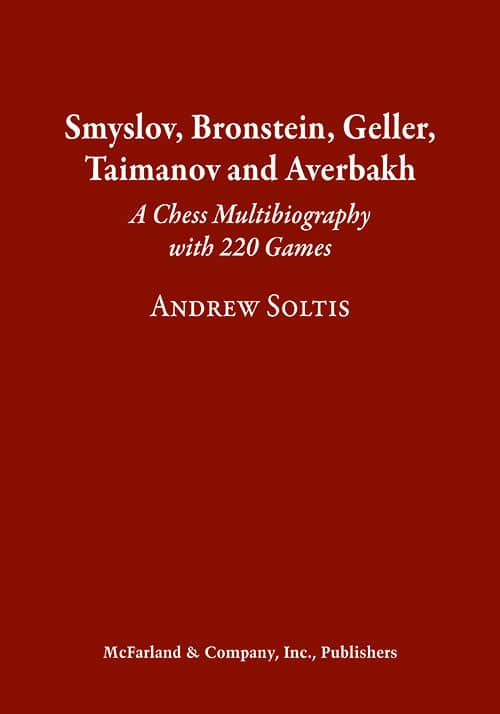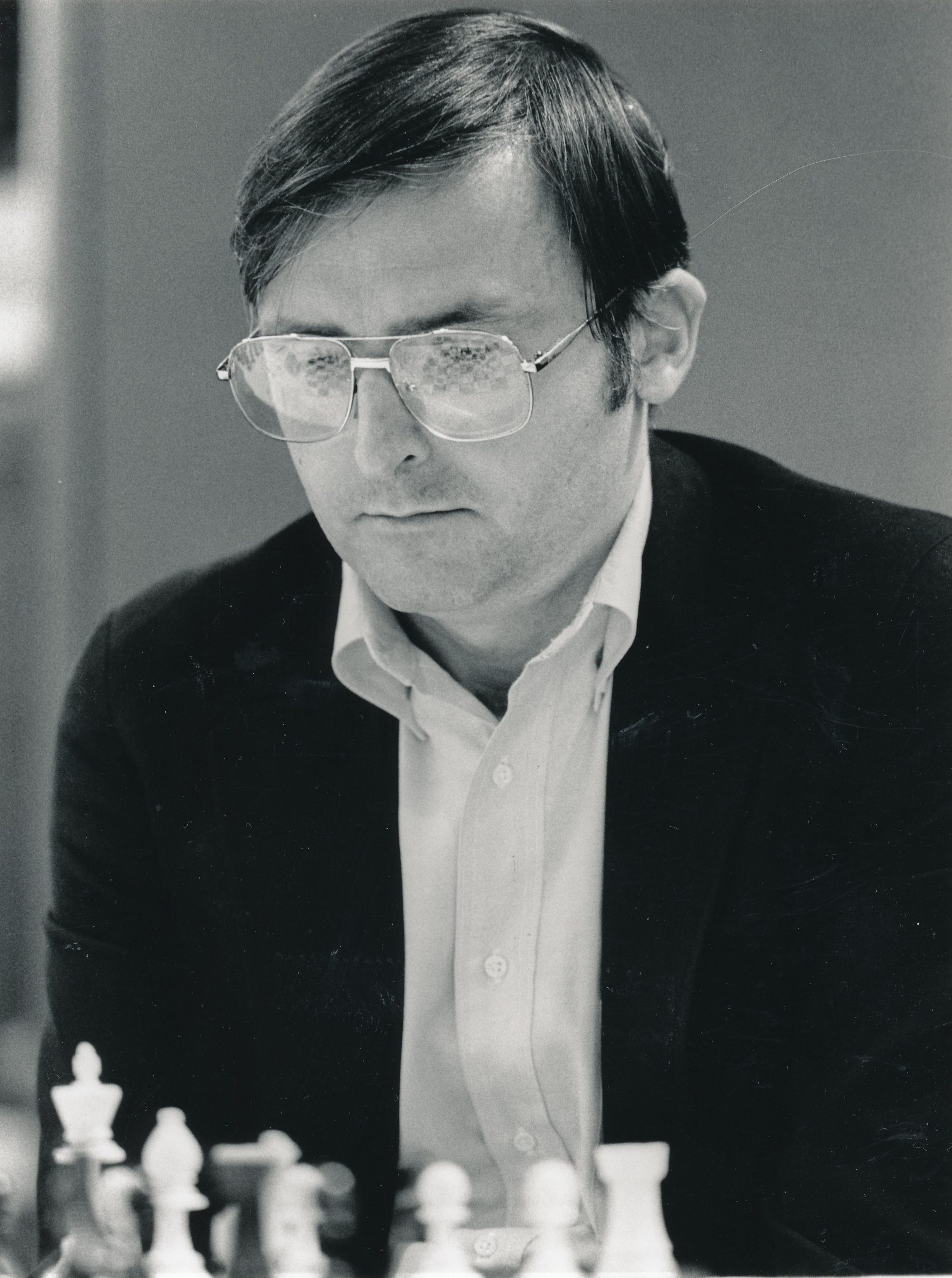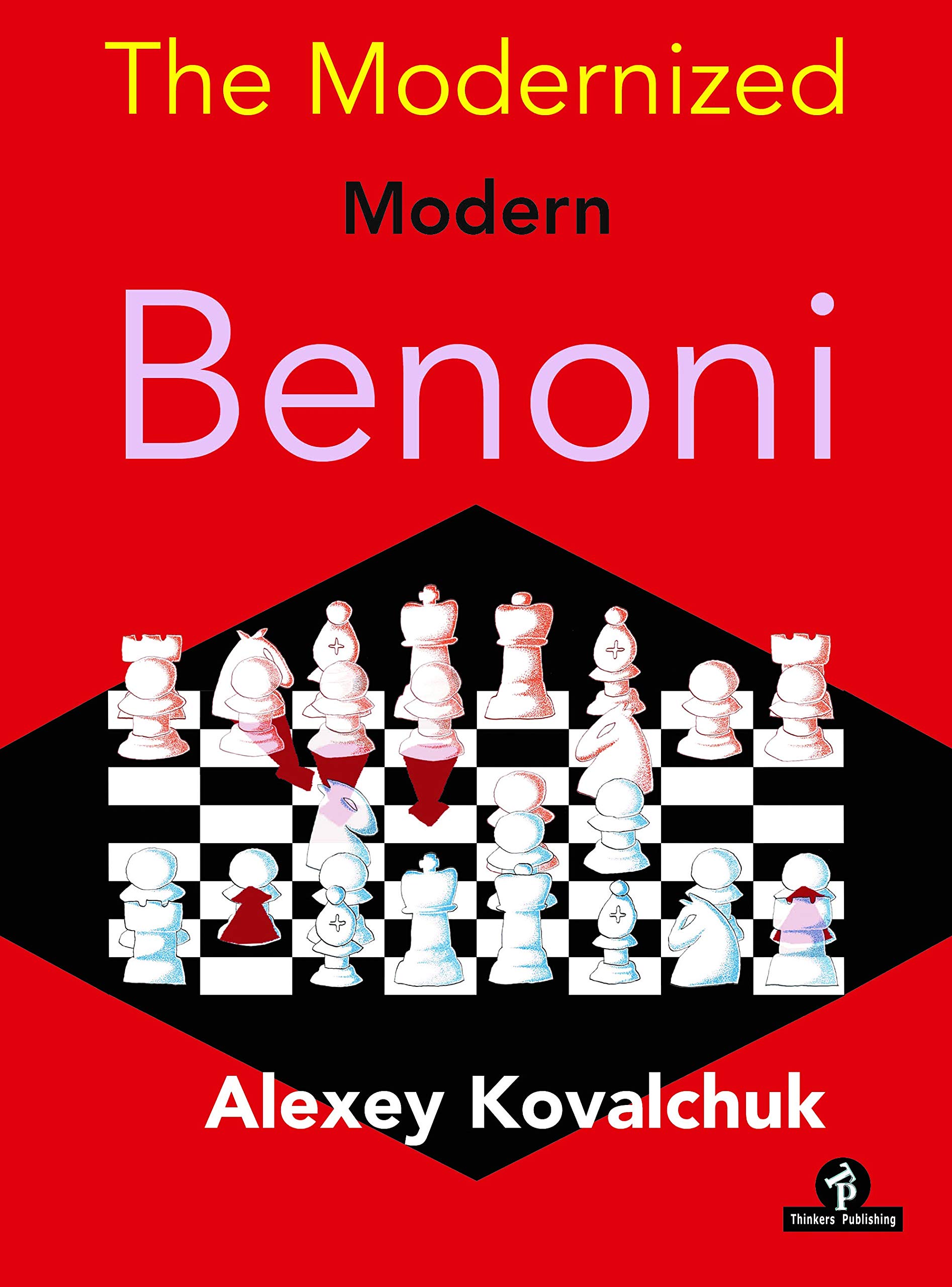
From the publisher’s blurb :
“A crucial decision spared chess Grandmaster David Bronstein almost certain death at the hands of the Nazis—one fateful move cost him the world championship.
Russian champion Mark Taimanov was a touted as a hero of the Soviet state until his loss to Bobby Fischer all but ruined his life.
Yefim Geller’s dream of becoming world champion was crushed by a bad move against Fischer, his hated rival.
Yuri Averbakh had no explanation how he became the world’s oldest grandmaster, other than the quixotic nature of fate.
Vasily Smyslov, the only one of the five to become world champion, would reign for just one year—fortune, he said, gave him pneumonia at the worst possible time. This book explores how fate played a capricious role in the lives of five of the greatest players in chess history.”

“Grandmaster Andy Soltis, eight times champion of the Marshall Chess Club, New York Post editor and Chess Life columnist, is the author of dozens of chess books. He lives in New York City. He is the author of many books, including Pawn Structure Chess, 365 Chess Master Lessons and What it Takes to Become a Chess Master”
From the author’s preface:
In this book I explored the interlocking careers of five men with a focus on the prime years when they might have become champion. Only one succeeded. But they represented an extraordinary class. All five men were ranked among the world’s top 11 players when Vasily Smyslov became champion. All five players were ranked in the world’s top 20 players for the next decade.
This book is a companion to my Tal, Petrosian, Spassky and Korchnoi and, like it, it pays tribute to the remarkable personal lives of great players during a remarkable era. They were not only competing with one another for the highest reward chess can offer. They were trying to survive in a brutal Soviet system. They lived through the Great Terror – which directly touched the lives of David Bronstein, Yuri Averbakh, Vasily Smyslov and Mark Taimanov – and World War II, which deeply affected them all.
Here, then, we have a group biography of five leading Soviet grandmasters, all born between 1921 and 1926. As Soltis explains, this was both a good time and place, and a bad time and place to be born. They grew up within a strong chess culture, where their talents were, albeit with deprivations during World War II and many restrictions in the brutal Soviet regime, allowed to flourish.
Smyslov became world champion, and Bronstein came very close. The other three were all world championship candidates, and, had things worked out slightly differently, Taimanov and Geller might have come closer to the title than they did.
Perhaps Smyslov, whose father was a strong player, would always have discovered chess, although, had his life turned out differently, he could have had a career as an opera singer. Taimanov, as is well known, did in fact have a parallel career as a pianist, performing with his first wife, Lyubov Bruk.
In another life, Bronstein would have been a mathematician and Averbakh a scientist. Geller was, in several ways, the outlier of the group. Unlike the others, he was a late developer, so only joins the story after several years and chapters have passed. Unlike the others, also, he seems to have had, apart from sports, no interests outside chess, even though he worked as an aircraft engineer and studied political economy at university.
As you’d expect, there’s a lot of high quality and instructive chess within these pages. Here are a few, fairly random, examples.
Taimanov and Bronstein adjourned this position, with White to move, in a 1946 Soviet Championship Semi-Final. Bronstein and Averbakh were staying at the same hotel, and set up the position on a board.
Soltis takes up the story.
Taimanov was so sure of victory that he told Bronstein he had sealed 1. Ra7+ and showed him how he would win after 1… Kh6 2. Rb7!. That looked convincing: 2… Ng3 3. Rb3 Nh5 (3… Nf5 4. Kf6) 4. Rh3! and then 4… Kg7 5. f5 Kf7 6. f6! wins. “But what if I retreat the king to f8?” Bronstein asked Averbakh.
The next day was free from play so they analyzed 1… Kf8 during it. They realized that if White traded pawns too quickly the result would be a position know to be drawable since an ancient game Neumann – Steinitz, Baden-Baden 1870. White did not seem to have a forcing win after 1… Kf8. But 2. Rd7! was a good waiting move. Then 2… Ke8 3. Rh7 Kf8 4. f5 would lose. So would 2… Ng7 3. Kf6 Nh5+ 4. Kg5! or 2… Ng3 3. Kf6.
This was discouraging. Bronstein and Averbakh looked at 2… Kg8 and unfortunately found 3. Ke6! Nf4+ 4. Kf6!. The clever king triangulation wins after 4… Nh5+ 5. Kxg6 Nf4+ 6. Kg5 Ne6+ 7. Kf6! Nf4 8. Rd4 Nh5+ 9. Kg6. Or 8… Ne2 9. Rg4+ Kf8 10 .Ra4 Kg8 11. Kg6 Kf8 12. Rc4 Ng3 13. Rc3 and so on. They kept analyzing and found that 3… Kf8 was no better than 3… Nxf4+ because of 4. Rf7+! Ke8 5. Rf6! or 4… Kg8 5. Ke7.
It was all so elegant and, simultaneously, depressing. “David didn’t know what to do, to be happy or sad,” Averbakh remembered. “Of course, it’s painful to know you have a forced loss. But what an interesting path to victory!” And, besides, they were both proud to have solved such a mysterious endgame.”
When the game was resumed, Taimanov played 1. Ra7+ Kf8! 2. f5? gxf5 and drew along the lines of the Neumann – Steinitz game.
As a result of this experience, Averbakh decided that he could combine his interests in science and chess by conducting research into technical endings such as this – and he would later become known as perhaps the world’s leading authority on endgames.
The games are expertly chosen, for their excellence, excitement, historical or sporting significance, and annotated in Soltis’s signature narrative style.
Some of them will be familiar to readers with a prior knowledge of games of the period, but others will be unfamiliar to most.
Look, for instance, at a couple of games from a secret training tournament held in the Georgian town of Gagra in 1953.
This is the game between Geller and Smyslov. Geller had outplayed the future world champion in the opening and early middle game, but his last move was an oversight. The last moves had been 25. Bb2-e5? Qc7-b6 26. Nf3xg5?.
Here’s Soltis:
This would have won after 25… Qa5? because of Qh5; e.g., 25… Qa5? 26. Nxg5! Nxd5 27. Qh5! and mates. In the diagram Geller must have expected to win after, for example, 26… Bxg5 27. Qh5! Bh6 28. Rg3!. Or 27… Re7 28. Be4! g6 29. Bxg6 Rxg2 30. Bf7+ Kf8 31. Bg7+!. 26… Nxd5! 27. cxd5 But he had overlooked 27. Qh5 Qb1+ 28. Kg2 Qg6!. No recovery is possible.
I have a couple of small issues with this. I find the back-referencing – something Soltis often does – slightly confusing. I’d have preferred the variation given in the first sentence here as a note to Black’s 25th move. He also fails to mention that Geller would still have been better in the game after 26. Rb2!, when a nice variation is 26… h6 27. Nh4! gxh4 28. Qh5!, with a winning attack.
Smyslov went on to win a few moves later.
Here, from the same tournament, is a position from the exciting game between Taimanov and Averbakh, with Black to make his 38th move.
Now 38… b1Q would make a draw likely, after 39. Rxb1 Rxa4 (40. Rh1?? Ra2+ and 39. Qxb1 c2!). 38… f5?? 39. d7! c2 40. d8Q+! (The final shift would have been 40. dxc8Q+? Rxc8 41. Qxf5 c1Q and Black wins. 40… Qxd8 41. Qxd8+ Kg7 42. Qg5+ Black resigns
(Taimanov, in his notes to this game, claimed White was winning the diagrammed position, failing to mention the draw after b1Q or to query 38… f5.)
Soltis, as so often, has an anecdote at hand to add colour and context.
The secrecy surrounding these training tournaments was deeply felt. Alexey Suetin recalled how one of the Gagra players showed him a remarkable game but “outright refused to give the names of the players” or the tournament results. “Such was the Stalist regime,” he said. Even when he wrote this, in 1993, Suetin refused to say who showed him the game. It was too dangerous.
In 1957 Bronstein was invited to a major tournament in Dallas, with the highest prize fund of any US tournament since New York 1927, but, according to Soltis, the State Department refused him a visa, apparently in retaliation for Soviet treatment of U.S. citizens seeking to travel in the USSR.
Instead, he had to make to with a weaker tournament in East Germany, where he reached this position with white against Bilek.
Soltis, again:
Bronstein has a deliciously subtle threat: 34. a4 would force the b6-rook to make a choice. Then 34… Rc6 would allow 35. Bf4 and Rb1-b8+. And 34… Rb3 would weaken f6 so that 35. Bh6! threatens 36. Qh7+ (35… Kf8 36. Qxf6+). 33… Kf8 34. g3 Re2 35. Bc1 Qe7 36. Kg2! There is no defence to 37. Rh1, 38. Rh7 and Bh6. The game could also end with 36… Re1 37. Rxe1 Qxe1 38. Ba3+. 36… Rc6 37. Rh1 Rxc3 38. Bf4 Ra3 39. Rc1! Black resigns.
(Bronstein has other threats in the diagrammed position: g3, Kg2 and Rh1 as happened later in the game, and also Bc1-a3. It takes older engines some time to realise White has anything more than a slight advantage, but Stockfish 14 immediately tells you almost any reasonable move is crushing.)
The narrative stops rather suddenly at the end of 1973, at which point our protagonists were in middle age and starting an inexorable decline. Unexpectedly, though, Smyslov would make another challenge for the world championship in his sixties. The remainder of their lives is chronicled relatively briefly.
What we have here is, as anyone familiar with this publisher will expect, a handsome hardback which will look good on any bookshelf. It covers an important and endlessly fascinating period of chess history, and is full of interesting (for all sorts of reasons) games, well researched and sourced history, entertaining and enlightening anecdotes and evocative photographs.
At the end of the book we have some useful appendices and other material. First, a chronology taking us through almost a century from Smyslov’s birth in 1921 through to Averbakh (still alive as I write this at the age of 99) playing a 4-year-old in 2017. Then, the rankings (from Chessmetrics) of the players between January 1939 and January 1979. We have chapter notes and a bibliography: everything is fully sourced, using Russian and English language periodicals and a wide range of books. There are frequent contradictions between sources, and the players also contradicted themselves from time to time: all this is explained in the text. Finally indexes of opponents and openings, and a general index.
It would have been ideal if the games had been presented more spaciously and with a lot more diagrams to enable readers to follow them from the page. It would also have been preferable to print the photographs on glossy rather than matt paper. Of course, given the nature of the book, such luxuries are inevitably out of the question. It would, however, have benefitted from another run through to pick up typos, of which there are more than should be expected in a scholarly work of this nature. I suspect, for example, that Keres told Taimanov he was playing like Liszt rather than List.
Nevertheless, this is an outstanding book which can be highly recommended to anyone interested in this period of chess history. If you’ve read Soltis’s earlier book on Tal, Petrosian, Spassky and Korchnoi you’ll need no hesitation to add this title as well. Likewise, once you’ve read this book, you’ll want to read the earlier work if you haven’t already done so.
In my opinion, Andrew Soltis is a very much underrated author. It’s understandable that we all tend to be suspicious of the quality of books produced by prolific authors, and in many cases these suspicions are justified. In the case of Soltis, though, even his more popular works are well written and, for their target audience, worth reading. His more serious and scholarly works such as this one are uniformly excellent. Soltis, with many years journalistic experience, knows how to write, and, most importantly, knows how to tell a story. Whether annotating a game or writing about chess history, he keeps his readers on the edge of their seats, eager to turn the page and find out what happens next. This book, like everything he writes, is extremely readable as well as rigorously sourced.
It’s not the last word on the subject. There is without doubt a wealth of interesting information lurking within currently sealed Soviet archives. Although this book might not be flawless, it will more than suffice for the moment. There’s nobody better qualified than Andrew Soltis to write on this subject.
This book doesn’t come cheap, but, if you can afford it, it will be money well spent. I see it has just made the shortlist for the English Chess Federation book of the year, and rightly so as well.
Richard James, Twickenham 2 September 2021

Book Details :
- Format: Hardback
- Pages: 380
- Bibliographic Info: photos, diagrams, games, bibliography, indexes
- Copyright Date: 28th February 2021
- pISBN: 978-1-4766-7793-4
- eISBN: 978-1-4766-4053-2
- Imprint: McFarland & Company Inc.
Official web site of McFarland





